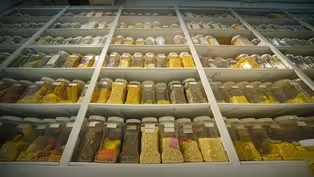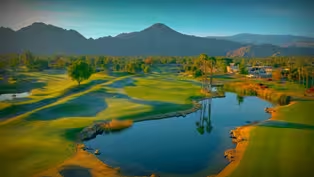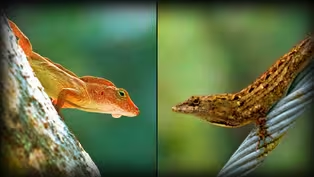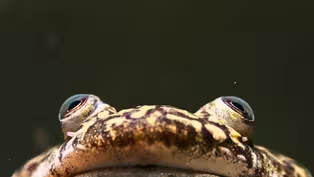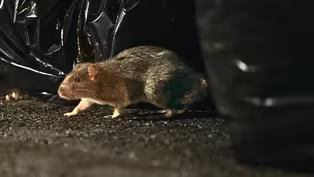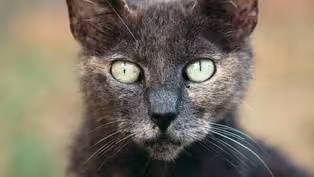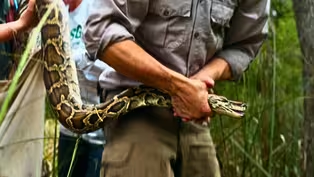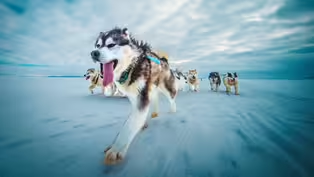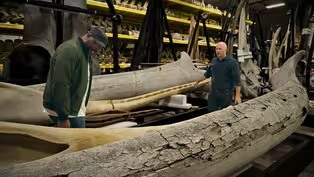
Singapore: Designing a Megacity in Harmony with Nature
Special | 13m 24sVideo has Closed Captions
Green spaces aren't just an afterthought here - they're mandatory!
Who says a densely populated city can't be a green paradise? Not in Singapore! Shane Campbell-Staton visits visionary architect Pearl Chee and legendary urban planner Professor Cheong Koon Hean to find out how creators like them have woven nature into the fabric of the city. Green spaces aren't just an afterthought here - they're mandatory!
Problems playing video? | Closed Captioning Feedback
Problems playing video? | Closed Captioning Feedback

Singapore: Designing a Megacity in Harmony with Nature
Special | 13m 24sVideo has Closed Captions
Who says a densely populated city can't be a green paradise? Not in Singapore! Shane Campbell-Staton visits visionary architect Pearl Chee and legendary urban planner Professor Cheong Koon Hean to find out how creators like them have woven nature into the fabric of the city. Green spaces aren't just an afterthought here - they're mandatory!
Problems playing video? | Closed Captioning Feedback
How to Watch Human Footprint
Human Footprint is available to stream on pbs.org and the free PBS App, available on iPhone, Apple TV, Android TV, Android smartphones, Amazon Fire TV, Amazon Fire Tablet, Roku, Samsung Smart TV, and Vizio.
Buy Now

Surprising Moments from Human Footprint
Do you think you know what it means to be human? In Human Footprint, Biologist Shane Campbell-Staton asks us all to think again. As he discovers, the story of our impact on the world around us is more complicated — and much more surprising — than you might realize.Providing Support for PBS.org
Learn Moreabout PBS online sponsorshipMore from This Collection
Human Footprint is a show that delves into the impact of humans on the planet. Join Shane as he travels from farms to restaurants, from high-tech labs to street markets, and from forests to cities to uncover the consequences of our unique history. Are you ready to explore our past, present, and future as a species?
Video has Closed Captions
Watch the rise of a productive crop that has managed to replace itself, but at what cost? (11m 24s)
The Watery Price Of Golf Courses & Lawns
Video has Closed Captions
The cultural and resource costs for manicured lawns and golf courses are quite shocking. (11m 29s)
How Dogs Are Shaping The Future Of Medicine
Video has Closed Captions
Observe the rich diversity of dog breeds, shaped by genes and human intervention. (12m 43s)
We Brought This Fish To America. Now We Can't Get Rid Of It
Video has Closed Captions
Expose Asian carp for disrupting native fish species and shrinking their populations. (10m 39s)
Why Are These Urban Lizards Evolving in Overdrive?
Video has Closed Captions
Examine city-dwelling anoles with remarkable evolutionary changes. (10m 33s)
How An Ancient Ocean Shaped Us History
Video has Closed Captions
Learn how millions of years of deposits shaped the events of Black American history. (16m 54s)
Video has Closed Captions
What happens when frogs become indispensable? (8m 59s)
Video has Closed Captions
When it comes to NYC, the rat is the undisputed king! (13m 26s)
Your Cat’s Secret Life (as a Deadly Predator)
Video has Closed Captions
Cats have been winning the hearts of humans for years....but can devastate ecosystems. (10m 40s)
How Giant Pythons Became Florida’s Biggest Invasive Species
Video has Closed Captions
Ever heard of the phrase "when pet pythons outgrow their owners"? (13m 24s)
Sled Dogs: The Most Extreme Distance Athletes on Earth
Video has Closed Captions
In the Arctic, it's not just about muscle power, but brainpower too. (15m 17s)
Secrets of the World’s Only Whale Warehouse
Video has Closed Captions
Uncover the history of whaling and its impact on our oceans. (9m 58s)
Providing Support for PBS.org
Learn Moreabout PBS online sponsorshipThe species in this building is higher than the species on the ground park.
Oh, really?
Yeah.
Which is right nearby.
So– Wait.
So there's more species within this construction...
Within this.
Than in like a natural space of...
Correct.
The same amount of greenery?
Yeah.
Correct.
That's incredible.
Thinking about an entire city built like this... Basically, you're talking about reforestation and urbanization as sort of one and the same.
Correct.
In every city I’ve ever lived in, green spaces felt like an escape.
They were in the city, not of the city.
But here in Singapore, nature is always around you.
And that’s by design – a design that’s not only benefiting our own species, but other species too.
So what can we learn from Singapore?
How do you design and build an environment where nature and urban living coincide, and even thrive together?
I’m Shane Campbell-Staton, and this is Human Footprint.
Is it your first time in Singapore?
It is.
Man this place, it’s, I've never seen anything like it.
It's incredible.
If you ask Pearl Chee, she’ll tell you it’s no miracle.
It's all part of the plan.
We are challenging ourselves as architects.
Whether we can design better… We are creating a lot of concrete buildings, it’s like a concrete jungle.
But we really want to bring the jungle in.
Pearl is the architect who designed the Kampung Admiralty, the building we’re standing in now.
Our design concept, it's a very unique combination.
We actually have elderly housing, public housing, combined with healthcare, which is a medical center, commercial and some social programs, and a food court.
Yeah.
Oh wow.
So that’s why it’s not gated.
It’s very open.
Anybody can actually come in and use the facilities here.
Singapore is the third most densely populated city in the world.
The entire country is an island with only 281 square miles of land, but 5 ½ million people live here.
In a city this dense you wouldn’t expect much room for nature.
But it’s like they say: where there’s a will, there’s a way.
And by will, I mean law.
Legislation enables it to happen.
The building took the land.
So we need to do replacement.
The legislation actually requires a building to give back 100% landscape.
Oh!
100% of the site footprint has to be replaced into the building.
Every square inch of green space that you take up, you have to put back in...
Put back in, yeah.
into the building somehow.
…into the building.
A few years after completing the building, Pearl’s firm surveyed the animal life in Kampung Admiralty’s gardens.
Fifty different species had moved in.
This development is a microcosm of what’s happening all over Singapore.
It’s not just one building, or designer, or architecture firm – the whole city is teeming with life.
As a biologist, I think a lot about sort of wildlife, specifically in urban spaces and how urban environments can be very stressful, very different environments.
But your job has been the opposite, to make urban environments very much like wild environments in a lot of ways.
What is your approach to increasing biodiversity in a space like this?
So visually, we want to have some interest in the landscape.
Secondly, we introduce a lot of edibles.
So you see a lot of fruit trees actually here.
That attracts the birds, mammals, and insects.
Also, because we did it in a cascading form, so it's actually quite connected all the way to the ground floor.
The landscape is actually connecting.
We have a system of collecting the water as well.
That's why the cascading planters, the water actually get filtered through all the way.
Just by gravity?
By gravity.
Yeah.
We have cascading landscape over there.
The planters and the water can come through under the planter.
Actually, this is a rain garden that collects all the filter water... Oh, wow.
... from all the planters.
Then, it gets stored in the tanks underneath the apartment blocks.
We have two rainwater harvesting tank underneath.
Whoa.
Yeah.
And then get pumped up and rewater again.
So, we're trying to recycle water.
As you sort of move around the city now, do you go to places and you're like, "Oh this is my baby?"
Yeah, yeah.
All the time… Professor Cheong Koon Hean is a music lover and life-long Singaporean.
She’s also a legendary urban planner.
A lot of folks credit her with shaping Singapore’s singular urban landscape.
This is one of my favorite neighborhood centers in a public housing estate.
Because in Singapore, 80% of the people live in public housing in estates like this.
Oh wow.
In highly affordable housing.
Kampung Admiralty, the building Pearl Chee designed, is public housing too.
And these places are cush.
The apartments are modern and clean, the amenities are incredible, and most developments are a 10-minute or less walk from public transportation.
And of course, everything is draped in greenery, from the street level to the tops of the skyscrapers.
Where I come from, when we say public housing, basically we call it the projects.
And I was actually raised a lot in public housing.
And that public housing and this public housing are not the same thing.
Well, you can’t believe it when you come to Singapore today, but say about 60-70 years ago, actually, Singapore was a nation of slums and squatters.
It was also polluted and lots of traffic congestion.
…Singapore was a British colony.
And actually if you look at the transition in 1819 when the British so-called founded Singapore; we had like 200 people on the island.
Oh, wow.
But today we are 5.7 million.
So you can imagine that rapid urbanization that took place.
When Singapore gained its sovereignty from Britain in 1959, it was a city of 1.5 million people and massive, unplanned sprawl.
Tens of thousands of people had no place to live.
So the newly elected government created the HDB, or Housing and Development Board.
And within five years, the HDB, they already built 51,000 units of flats… It started from very basic housing, but now of course the quality is a lot better as can see around you.
Yeah.
And public housing is just the beginning.
Singapore is a very small city-state.
It’s actually only half the size of metropolitan London.
Oh wow.
But we are a country, we are not just a city.
So everything you need about a country, whether it’s for water, power generation, ports, airports, plus housing, shops, offices, industry, all has to be built within this tiny island city-state.
And so biodiversity and ecological balance became really quite an important concept.
Now, as we develop the land, of course we start to lose space for planting.
So what did we do?
We decided to move the greenery upwards into the sky… And so what you did is you just created a new space, and suddenly you bring back all the biodiversity.
Back in the States, urban areas and wildlife are sort of like oil and water.
They don’t mix very well.
But what you’ve done here is something very, very different.
Over the years, we moved from being a garden city to a city in the garden because we started to plant so extensively.
And in the last decade or so we moved from a city and a garden, to city in nature.
In a place where you have limited space and you have this growing population that there are two very sort of competing needs.
Shane, absolutely there's always competing needs.
Right?
So it's really this very important balancing act of allocating the right amount of land for different uses, to create this type of an environment.
So what do you think a Singaporean gains by having nature sort of infused within the urban environment as opposed to setting aside natural park space, like national parks?
There's a lot of science behind planting.
For example, to thermal comfort.
And the right plants, if it's planted along pathways, it provides a lot of shade.
Despite being an island nation where 100% of its population lives in urban areas, this city-state is known as the greenest city in Asia.
Here, “green” takes on many meanings - and high on that list is shelter from the sweltering heat in this tropical environment.
Plants and vegetation play a big part of that, lowering the air temperature by 1 to 2 degrees Celsius!
So in fact, in the design of the towns, we use a lot of computer models.
The way you juxtapose your buildings with parks and open spaces, you bring in the breezes, which is important to cool the town and for better air quality and natural ventilation.
And of course we bring back biodiversity.
If you plant the right type of plants, you can get back the butterflies, and the dragonflies, and you get the Monitor lizards coming back.
Yeah, I’ve seen several really large monitor lizards in the city!
And who orchestrates this balancing act?
It’s the Singaporean government, with their comprehensive “Master Plan” for managing the city-state’s ongoing growth.
By centralizing the control of urban development, Singapore paves the way – you see what I did there – for projects that fuse function and form.
If you look behind us… The Punggol waterway is actually a man-made river.
We dammed up two rivers… to become freshwater reservoirs.
Now, the engineers wanted to connect the two reservoirs with a pipe.
Very functional.
Yeah.
But then the architects and the planners say, why do a pipe?
Why don't we make a river?
And so this river connected the two reservoirs to balance and optimize the storage of water, but at the same time, it became a leisure facility.
So Punggol has a nickname - it’s the Venice of Singapore.
Oh, that's amazing.
Because we brought in water, right?
It has its aesthetics, but everything out also serves… Function, yes a function.
A very specific function.
Even the Punggol Waterway, there's a family of otters that have come back.
Oh, that's incredible.
They live on the Punggol Waterway.
Singapore challenges a lot of what I thought I knew about cities.
No one’s saying that we should all be like Singapore, or even that we could be.
This place is unique.
Ninety percent of Singapore’s land is publicly owned.
The government determines what gets built, and where.
And with everyone sharing the same tiny island, by definition, they’re all in this together.
Most places don’t have all that.
But I’m not sure we need it to re-imagine what cities can be.
I think the thing that stands out to me about Singapore is the intentionality.
I'm not sure if this specific model can be applied… anywhere or everywhere, but I think they're doing things that… I think other cities can learn from.
We have to get our act together to make cities effective.
Creativity, innovation and that will to survive and to want to do well are very, very strong drivers.
That’s human beings, right?
That’s what we are.
If you want more Human Footprint, you can tune in to the full length series on the PBS App or on your local PBS station.

- Science and Nature

Explore scientific discoveries on television's most acclaimed science documentary series.

- Science and Nature

Capturing the splendor of the natural world, from the African plains to the Antarctic ice.












Support for PBS provided by:
